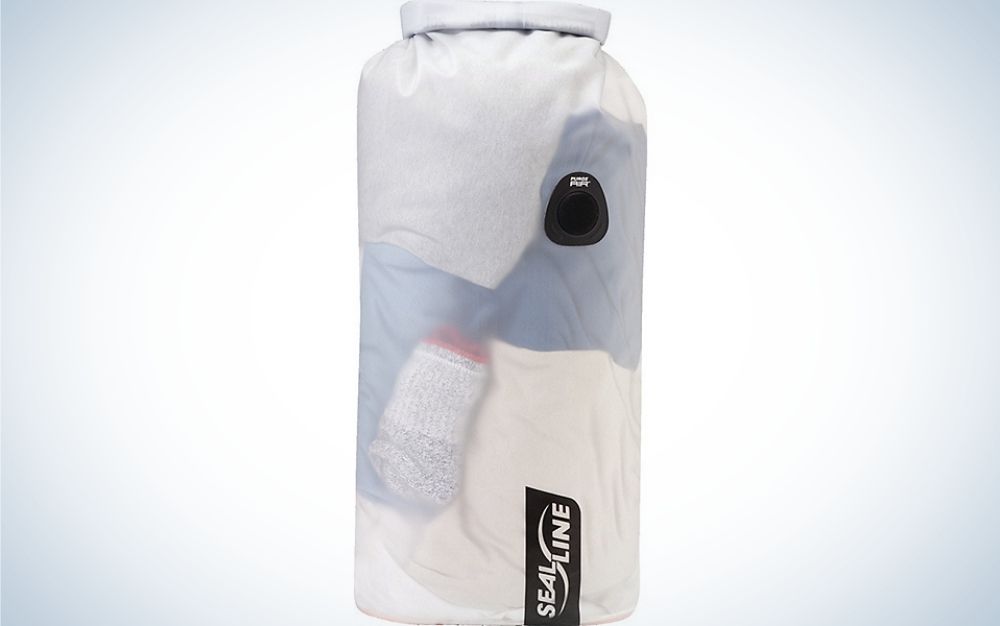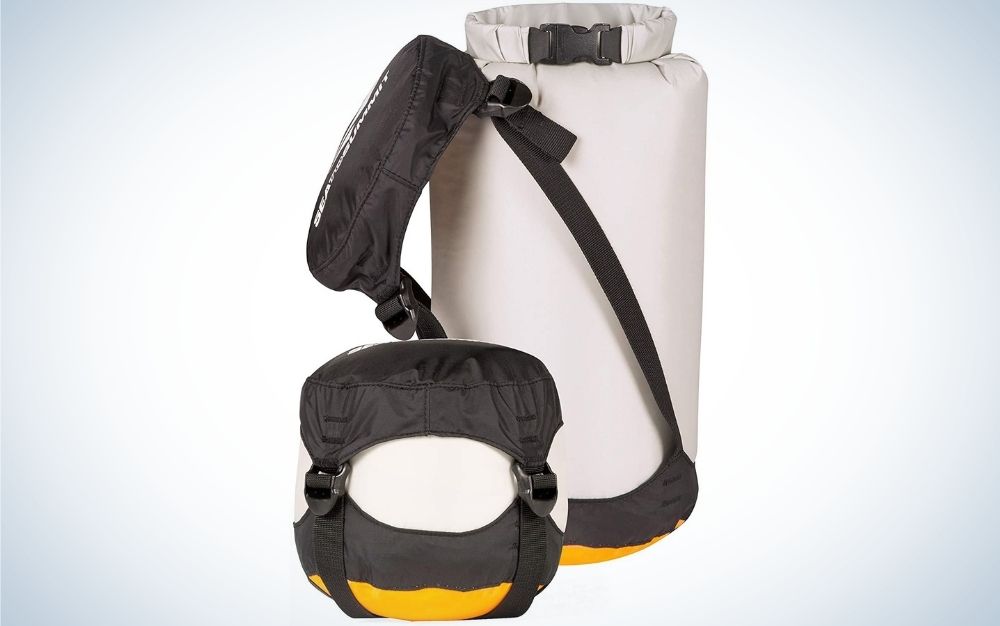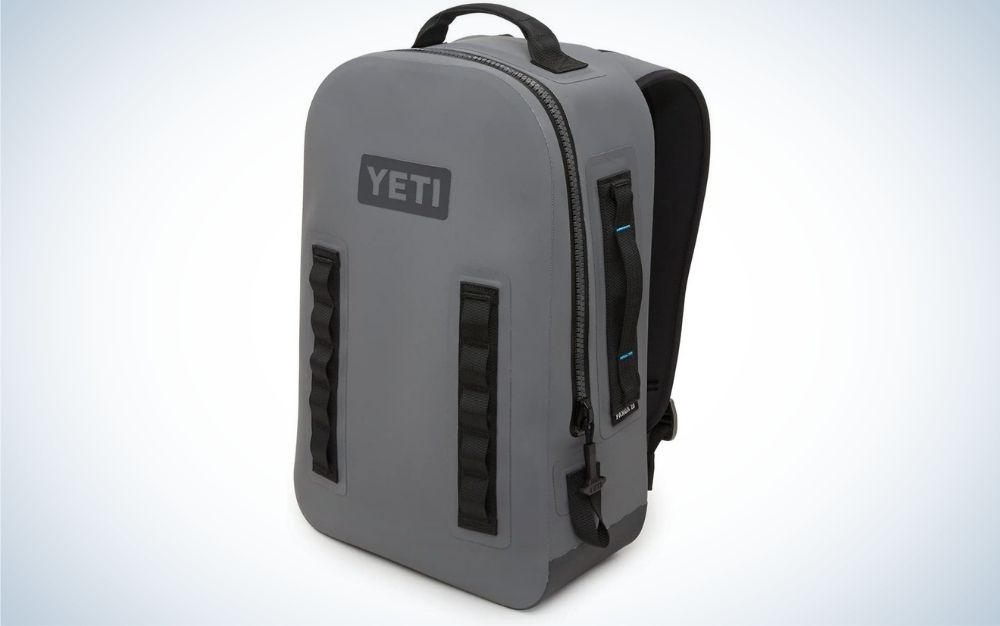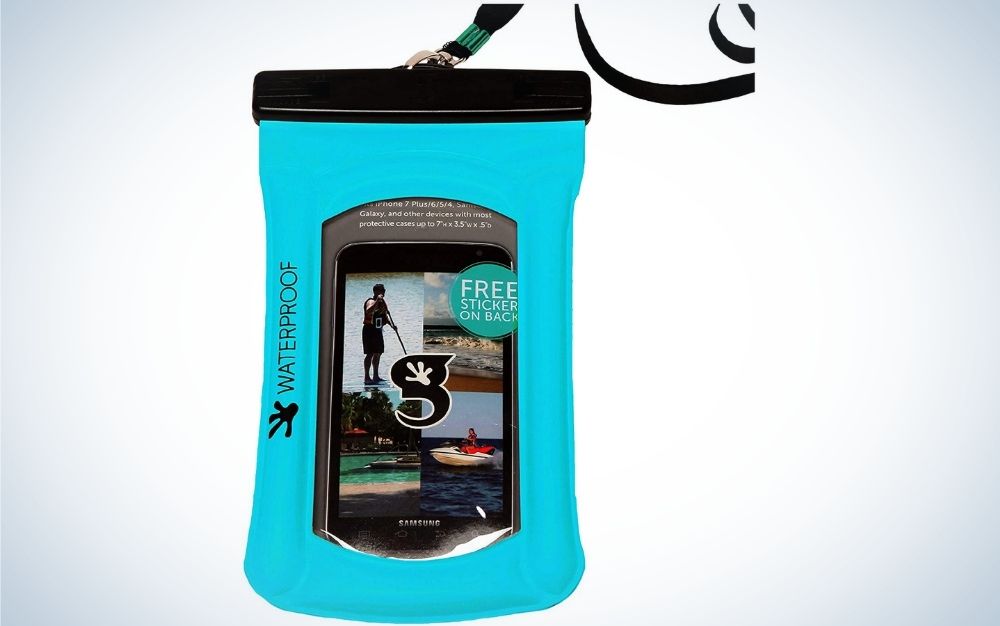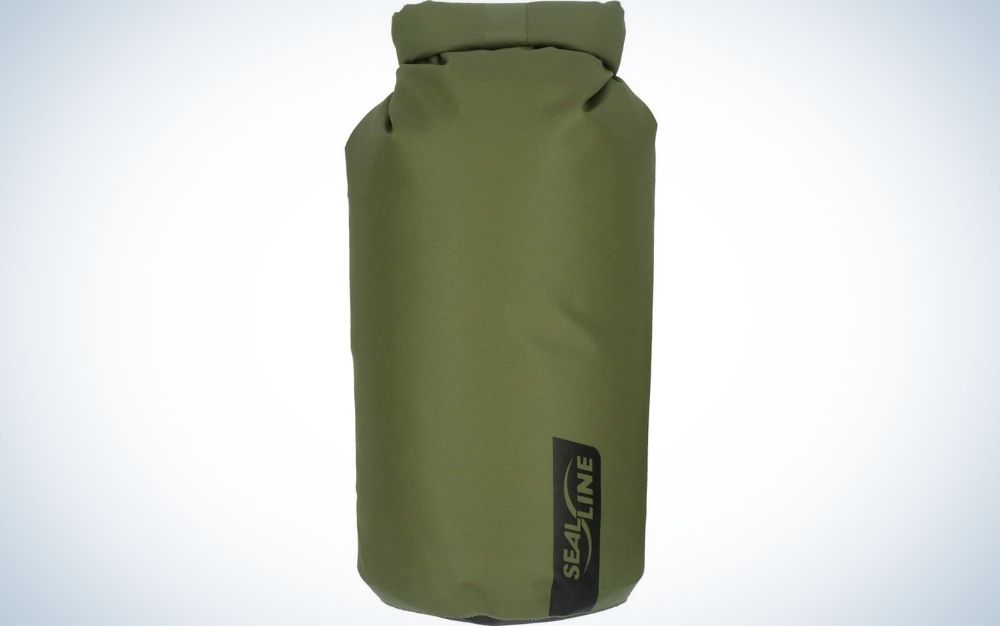We may earn revenue from the products available on this page and participate in affiliate programs. Learn More ›
Updated Mar 22, 2023 5:33 PM
Whether you’re fishing, hunting, camping, or kayaking, keeping some of your gear dry is a necessity…and a challenge. Ideally, the best dry bag not only keeps out rain, spray, dew and mist, but should float, close securely, stand up to the conditions, and be the right size for whatever valuables you want to keep dry, from clothes to electronics.
The best dry bag for kayaking (or canoeing) allows you to see contents without opening the bag, so you won’t have to remove gear while on the water to find what you need. The best dry bag for camping is lightweight and compresses to save space. If you have a lot of gear that needs protection from the wet and you’re going to be hiking, a waterproof backpack is probably your best choice. If you just want to keep your cell phone protected, a cell phone dry bag is best.
Best Overall: NRS Tuff Sack
Whether you’re guiding clients every day or spending weeks on the water or in the field, the NRS Tuff Sack is a smart choice. Puncture-resistant and tear-resistant material, welded seams, a reinforced roll-top closure, and beefy buckles makes the Tuff Sack one of the toughest waterproof dry bags. The Tuff Sack comes in sizes from five to 55 liters. The five-liter size is most popular as a ditch bag or quick- grab storage for essentials like sunglasses, sun block, smartphone, and some spare dry clothes.
Best for Kayaking: SealLine Discovery View
The Discovery View bag is made of a semi see-through material to view the contents without opening the bag. The PVC material is puncture- and rip-resistant. A heavy duty collar and buckles make closing and sealing the bag intuitive. If you want to save space and compress the bag, a special valve lets air escape after the top is closed.
Best for Camping: Sea to Summit eVent Compression Dry Sack
A unique combination of fabrics allows air to purge from the eVent Compression Sack without a purge valve. A reinforced lid, sturdy bottom, and non-wicking roll-top closure keeps water out. Four straps cinch down the bag to compress the contents. It’s available in five sizes.
Best Backpack: Yeti Panga
Overbuilt and reinforced, the Yeti Panga Backpack is the best dry bag backpack for hopping from one outdoor activity to another. Made of whitewater raft material, with an oversized waterproof zipper, the Panga waterproof backpack is air tight and completely waterproof. It has padded shoulder straps and a ventilated spine with a chest and hip belt to distribute the weight.
Best for Cell Phones: Geckobrands Float Phone Pouch
Geckobrands Floating Phone Pouch is the best dry bag for phones and offers top-notch protection. Access all the phone’s functions through a window in the bag, even underwater. Test the seal to ensure the phone stays dry.
Best Budget: SealLine Baja Dry Bag
The SealLine Baja is a basic 5-liter bag with a roll-top closure. It’s made of reinforced vinyl and has a heavy duty bottom. It’s available in four colors, making it easy and inexpensive to organize gear and keep it protected from the elements.
Features to look for in the best dry bag
A dry bag seems like a simple device—it’s a waterproof bag, right?—but finding the best waterproof bag requires some consideration.
First, look at construction and materials. Look for reinforced roll-top closure that won’t separate from the bag. The buckles should be easy to operate and sturdy. Zipper closures should be large, heavy and locking to close out moisture and hold air. Rip-stop material with inherent water-resistance protects gear from water and moisture without tearing or wearing thin. A D-ring on the bag is convenient for securing it to a kayak or canoe. Taped seams, closed with heat and adhesive, seal out leaks.
Then consider size. A five-liter bag is a good all-around size. Ten- and 20-liter dry bags have enough space for clothes, a sleeping bag or tent. Large dry bags make it easy to carry a pile of gear safe and dry.
If you need several, choose different color bags to keep gear organized.
To use a roll top dry bag, first, stuff the bag full of gear. While filling the bag, periodically shake the bag to pack down the contents. Once the bag is ⅔ full, fold the top of the bag over two times. Push the bag down to purge the air if you need to save space. If you want to maximize flotation, skip that step. Turn the top of the bag two more times to trap air, and clip the buckles at the collar. Test the seal by squeezing the bag while looking and listening for air to escape.
Do you want a dry bag for all-around use?
These bags are only as good as they are tough. Failed seals, broken buckles, ripped material, or compromised waterproofing end a bag’s effectiveness. Roll top dry bags are considered the best for protecting outdoor gear. This is because the seal can be tested and you can trap a lot of air in it if necessary to provide good flotation—meaning you’ll be able to spot the bag easily on the water if it should go overboard. These are some of the best dry bags for paddle boarding, rafting, and other popular water sports.
Kayak dry bags are must-have gear
Nothing stays dry on a kayak. Even inside the hull, water will puddle and eventually soak gear. And, gear in kayaks is subject to rough treatment, which makes a tough material mandatory. A bag that allows you see what’s inside is best, so you won’t have to sort through all your stuff and risk it getting wet while you’re looking for what you want.
Do you need a dry bag for camping?
Real-life camping often means encountering rain, fog and snow. A 15-liter bag is a good size for clothes or a sleeping bag, while a 30 liter bag will fit a tent, fly, tarp and more. Pack food in a 20-liter large bag so it’s available when the crew gets hungry. Weight is typically a consideration when camping, so a bag that’s lightweight but strong is a good choice.
One plus about a dry bag for camping: it helps reduce space by allowing you to compress soft items. Roll the top to seal the bag, then cinch it down to remove air and reduce the size of the bag. A five-liter bag will turn a puffy jacket into a softball-size package.
Do you want to carry a dry bag backpack?
A waterproof backpack offers the ultimate in convenience and utility. You never have to worry about your gear or clothing getting wet. If you have a lot of gear to keep dry and need to carry it a long way, the best dry bag backpack is the way to go.
Do you want to keep your cell phone dry?
Protecting an expensive smartphone from the elements isn’t easy, especially when kayaking or camping. The best dry bag for phones allows the user to operate the phone through a clear-plastic window in the bag. To make the bag even more convenient, most smartphone hard cases fit inside.
On a budget? What you get for less than $20
If you’re looking for an inexpensive bag, first make sure it truly is waterproof. Some bags have a waterproof closure, but the material itself is only water-resistant. That may work for your purposes, but if the bag is for use in a kayak or any other place where it’s bound to come into contact with water, make sure it’s 100 percent waterproof.
FAQs
Answers to some of your most common dry bag questions.
Q: Who makes the best dry bag?
Sealline and NRS are two known makers of good dry bags, but note that the best dry bags do more than keep gear dry. It depends on what you want to do with the bag. Bright colors help organize and access gear, and while translucent material allows you to see what’s inside without hunting around in the bag. If you have to go a long way, a waterproof backpack may be a better choice. In any case, look for sturdy materials, a beefy opening and buckles, and welded or taped seals keep water out.
Q: Are dry bags really waterproof?
The best dry bags really are waterproof. The roll-top closures or waterproof zippers have proven to seal out water. Advanced materials and construction make them puncture- and tear-resistant.
Q: What will a 10-liter dry bag hold?
A 10-liter dry bag will hold a change of dry clothes, a set of rain gear or a compact camp stove and utensils. A 10-liter bag will fit in a kayak bow hatch, in a large backpack, or under a car seat.
Why Trust Outdoor Life?
Since 1898, OL has been a leading authority in testing and reviewing hunting gear, fishing tackle, guns and shooting equipment, and much more. We have more than a century-long history of evaluating products, and we’re now bringing that expertise to online reviews. Our editors are experienced outdoorsmen and women, and most importantly, we’re trained journalists. We prioritize field testing and objective data when reviewing products. We conduct interviews with gear manufacturers and engineers as well as outdoor experts so that our readers have an understanding of how and why a product works—or doesn’t.
Advertising does not influence our gear reviews and it never will. While we always focus our coverage on standout products—because we want our readers to be aware of the latest and greatest gear—we also cover the flaws and quirks of any given product.
Final tips to find the best dry bag
Make double-sure that you close correctly. That may seem a simple thing when you’re at home, packing for a trip, but it’s something else when you’re on the water or in the woods and distracted by the fishing or the weather. A dry bag only works when it’s sealed properly, so take the time to make sure it’s shut tight.

